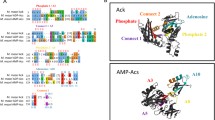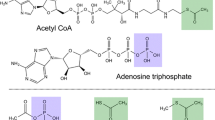Abstract
ADP-forming acetyl-CoA synthetase (ACD), the novel enzyme of acetate formation and energy conservation in archaea (\({\text{Acetyl - CoA}} + {\text{ADP}} + {\text{P}}_{{\text{i}}} \rightleftarrows {\text{acetate}} + {\text{ATP}} + {\text{CoA}}\)), has been studied only in few hyperthermophilic euryarchaea. Here, we report the characterization of two ACDs with unique molecular and catalytic features, from the mesophilic euryarchaeon Haloarcula marismortui and from the hyperthermophilic crenarchaeon Pyrobaculum aerophilum. ACD from H. marismortui was purified and characterized as a salt-dependent, mesophilic ACD of homodimeric structure (166 kDa). The encoding gene was identified in the partially sequenced genome of H. marismortui and functionally expressed in Escherichia coli. The recombinant enzyme was reactivated from inclusion bodies following solubilization and refolding in the presence of salts. The ACD catalyzed the reversible ADP- and Pi-dependent conversion of acetyl-CoA to acetate. In addition to acetate, propionate, butyrate, and branched-chain acids (isobutyrate, isovalerate) were accepted as substrates, rather than the aromatic acids, phenylacetate and indol-3-acetate. In the genome of P. aerophilum, the ORFs PAE3250 and PAE 3249, which code for α and β subunits of an ACD, overlap each other by 1 bp, indicating a novel gene organization among identified ACDs. The two ORFs were separately expressed in E. coli and the recombinant subunits α (50 kDa) and β (28 kDa) were in-vitro reconstituted to an active heterooligomeric protein of high thermostability. The first crenarchaeal ACD showed the broadest substrate spectrum of all known ACDs, catalyzing the conversion of acetyl-CoA, isobutyryl-CoA, and phenylacetyl-CoA at high rates. In contrast, the conversion of phenylacetyl-CoA in euryarchaeota is catalyzed by specific ACD isoenzymes.





Similar content being viewed by others
References
Adams MW, Holden JF, Menon AL, Schut GJ, Grunden AM, Hou C, Hutchins AM, Jenney FE, Kim C, Ma K, Pan G, Roy R, Sapra R, Story SV, Verhagen MF (2001) Key role for sulfur in peptide metabolism and in regulation of three hydrogenases in the hyperthermophilic archaeon Pyrococcus furiosus. J Bacteriol 183:716–724
Bock A-K, Glasemacher J, Schmidt R, Schönheit P (1999) Purification and characterization of two extremely thermostable enzymes, phosphate acetyltransferase and acetate kinase, from the hyperthermophilic eubacterium Thermotoga maritima. J Bacteriol 181:1861–1867
Bonete MJ, Pire C, LLorca FI, Camacho ML (1996) Glucose dehydrogenase from the halophilic Archaeon Haloferax mediterranei: enzyme purification, characterisation and N-terminal sequence. FEBS Lett 383:227–229
Bradford MM (1976) A rapid and sensitive method for the quantitation of microgram quantities of protein utilizing the principle of protein-dye binding. Anal Biochem 72:248–254
Bräsen C, Schönheit P (2001) Mechanisms of acetate formation and acetate activation in halophilic archaea [published erratum appears in Arch Microbiol 2003 180:504]. Arch Microbiol 175:360–368
Cendrin F, Chroboczek J, Zaccai G, Eisenberg H, Mevarech M (1993) Cloning, sequencing, and expression in Escherichia coli of the gene coding for malate dehydrogenase of the extremely halophilic archaebacterium Haloarcula marismortui. Biochemistry 32:4308–4313
Connaris H, Chaudhuri JB, Danson MJ, Hough DW (1999) Expression, reactivation, and purification of enzymes from Haloferax volcanii in Escherichia coli. Biotechnol Bioeng 64:38–45
Glasemacher J, Bock A-K, Schmid R, Schönheit P (1997) Purification and properties of acetyl-CoA synthetase (ADP-forming), an archaeal enzyme of acetate formation and ATP synthesis, from the hyperthermophile Pyrococcus furiosus. Eur J Biochem 244:561–567
Hansen T, Schönheit P (2001) Sequence, expression, and characterization of the first archaeal ATP-dependent 6-phosphofructokinase, a non-allosteric enzyme related to the phosphofructokinase-B sugar kinase family, from the hyperthermophilic crenarchaeote Aeropyrum pernix. Arch Microbiol 177:62–69
Hansen T, Reichstein B, Schmid R, Schönheit P (2002) The first archaeal ATP-dependent glucokinase, from the hyperthermophilic crenarchaeon Aeropyrum pernix, represents a monomeric, extremely thermophilic ROK glucokinase with broad hexose specificity. J Bacteriol 184:5955–5965
Hansen T, Wendorff D, Schönheit P (2004) Bifunctional phosphoglucose/phosphomannose isomerases from the Archaea Aeropyrum pernix and Thermoplasma acidophilum constitute a novel enzyme family within the phosphoglucose isomerase superfamily. J Biol Chem 279:2262–2272
Laemmli UK (1970) Cleavage of structural proteins during the assembly of the head of bacteriophage T4. Nature 227:680–685
Lamble HJ, Heyer NI, Bull SD, Hough DW, Danson MJ (2003) Metabolic pathway promiscuity in the archaeon Sulfolobus solfataricus revealed by studies on glucose dehydrogenase and 2-keto-3-deoxygluconate aldolase. J Biol Chem 278:34066–34072
Mai X, Adams MWW (1996) Purification and characterization of two reversible and ADP-dependent acetyl coenzyme A synthetases from the hyperthermophilic archaeon Pyrococcus furiosus. J Bacteriol 178:5897–5903
Musfeldt M, Schönheit P (2002) Novel type of ADP-forming acetyl coenzyme A synthetase in hyperthermophilic archaea: heterologous expression and characterization of isoenzymes from the sulfate reducer Archaeoglobus fulgidus and the methanogen Methanococcus jannaschii. J Bacteriol 184:636–644
Musfeldt M, Selig M, Schönheit P (1999) Acetyl coenzyme A synthetase (ADP-forming) from the hyperthermophilic Archaeon Pyrococcus furiosus: identification, cloning, separate expression of the encoding genes, acdAI and acdBI, in Escherichia coli, and in vitro reconstitution of the active heterotetrameric enzyme from its recombinant subunits. J Bacteriol 181:5885–5888
Oren A, Ginzburg M, Ginzburg BZ, Hochstein LI, Volcani BE (1990) Haloarcula marismortui (Volcani) sp. nov., nom. rev., an extremely halophilic bacterium form the Dead Sea. Int J Syst Bacteriol 40:209–210
Pire C, Esclapez J, Ferrer J, Bonete MJ (2001) Heterologous overexpression of glucose dehydrogenase from the halophilic archaeon Haloferax mediterranei, an enzyme of the medium chain dehydrogenase/reductase family. FEMS Microbiol Lett 200:221–227
Reeves RE, Warren LG, Susskind B, Lo HS (1977) An energy-conserving pyruvate-to-acetate pathway in Entamoeba histolytica. Pyruvate synthase and a new acetate thiokinase. J Biol Chem 252:726–731
Sanchez LB, Müller M (1996) Purification and characterization of the acetate forming enzyme, acetyl-CoA synthetase (ADP-forming) from the amitochondriate protist, Giardia lamblia. FEBS Lett 378:240–244
Sanchez LB, Morrison HG, Sogin ML, Müller M (1999) Cloning and sequencing of an acetyl-CoA synthetase (ADP-forming) gene from the amitochondriate protist, Giardia lamblia. Gene 233:225–231
Sanchez LB, Galperin MY, Müller M (2000) Acetyl-CoA synthetase from the amitochondriate eukaryote Giardia lamblia belongs to the newly recognized superfamily of acyl-CoA synthetases (nucleoside diphosphate-forming). J Biol Chem 275:5794–5803
Schäfer T, Schönheit P (1991) Pyruvate metabolism of the hyperthermophilic archaebacterium Pyrococcus furiosus. Acetate formation from acetyl-CoA and ATP synthesis are catalysed by an acetyl-CoA synthetase (ADP-forming). Arch Microbiol 155:366–377
Schäfer T, Selig M, Schönheit P (1993) Acetyl-CoA synthethase (ADP-forming) in archaea, a novel enzyme involved in acetate and ATP synthesis. Arch Microbiol 159:72–83
Schönheit P, Schäfer T (1995) Metabolism of hyperthermophiles. World J Microbiol Biotechnol 11:26–57
Schut GJ, Brehm SD, Datta S, Adams MW (2003) Whole-genome DNA microarray analysis of a hyperthermophile and an archaeon: Pyrococcus furiosus grown on carbohydrates or peptides. J Bacteriol 185:3935–3947
Srere PA, Brazil H, Gonen L (1963) The citrate condensing enzyme of pigeon breast muscle and moth flight muscle. Acta Chem Scand 17:129–134
Völkl P et al (1993) Pyrobaculum aerophilum sp. nov., a novel nitrate-reducing hyperthermophilic archaeum. Appl Environ Microbiol 59:2918–2926
Zhang P, Ng WV, DasSarma S (2003) Personal communication. http://zdna2.umbi.umd.edu, NSF grant reference (MCB-0135595)
Acknowledgments
We thank Prof. Dr C. Urbanke (Hannover, Germany) for determination of molecular mass of P. aerophilum ACD by analytical ultracentrifugation and Dr K. Schober (Braunschweig, Germany) for N-terminal aminoacid sequencing of H. marismortui ACD. The work was supported by grants from the Fonds der Chemischen Industrie. We also thank Dr S. DasSarma for providing access to the H. marismortui genome data at the UMBI web site http://zdna2.umbi.umd.edu/cgi-bin/blast/blast.pl and the web site URL http://zdna2.umbi.umd.edu/.
Author information
Authors and Affiliations
Corresponding author
Additional information
Dedicated to Prof. Dr. Dr. h.c. mult. Hans Günter Schlegel on the occasion of his 80th birthday.
Rights and permissions
About this article
Cite this article
Bräsen, C., Schönheit, P. Unusual ADP-forming acetyl-coenzyme A synthetases from the mesophilic halophilic euryarchaeon Haloarcula marismortui and from the hyperthermophilic crenarchaeon Pyrobaculum aerophilum. Arch Microbiol 182, 277–287 (2004). https://doi.org/10.1007/s00203-004-0702-4
Received:
Revised:
Accepted:
Published:
Issue Date:
DOI: https://doi.org/10.1007/s00203-004-0702-4




